P The problem of water disposal and wastewater treatment is relevant for any owner of suburban real estate. Therefore, if the developer has chosen an autonomous sewer system in a private house: how to choose the equipment, the characteristics of individual elements of the system - the most pressing issue before installation.
Autonomous sewerage in a private house - the best choice for a summer residence
Scope of application of autonomous sewer systems
Any home equipped with running water needs drainage and wastewater treatment. If the project includes an autonomous sewage system in a private house, how to choose equipment that combines a minimum construction and operation budget with high performance is the main question for the owner of a cottage who does not have a special education.
For garden and country houses budget option are septic tanks that can clean wastewater by 60 - 75%. Due to the seasonal, periodic operation of houses, the underground reservoir does not require annual pumping of sewage, which sharply reduces the operating budget. They are inexpensive and, if necessary, are made from concrete well rings.
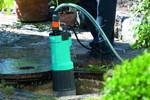
For year-round housing, VOC (local treatment plant), SBO (biological treatment station), and aeration tank systems using highly efficient anaerobic bacteria are more suitable. This equipment allows you to reuse treated wastewater; pumping is rarely done. However, the construction and maintenance budget is increasing sharply.
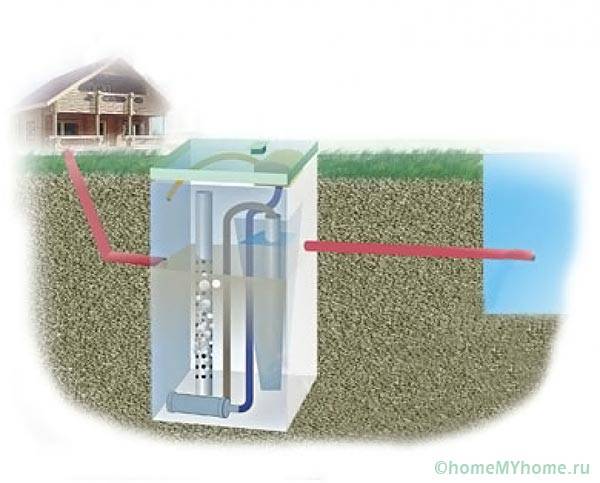
Autonomous sewerage design
Before you find out what an autonomous sewage system is in a private house and how to choose an option suitable for specific operating conditions, you need to consider the design of treatment facilities. There are several options for wastewater disposal systems with subsequent post-treatment:
- septic tank - several internal chambers connected by overflow pipes, in the largest of which the wastewater settles, loses large suspensions and mechanical impurities, the rest contain anaerobic bacteria that decompose organic matter without the presence of air;
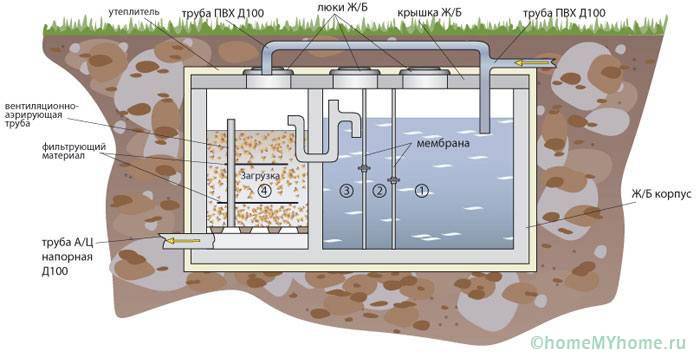
- aeration tank - the design is similar to the previous one, however, air is forced into the chambers, necessary for aerobic bacteria, which are capable of breaking down almost all organic impurities present in sewage;
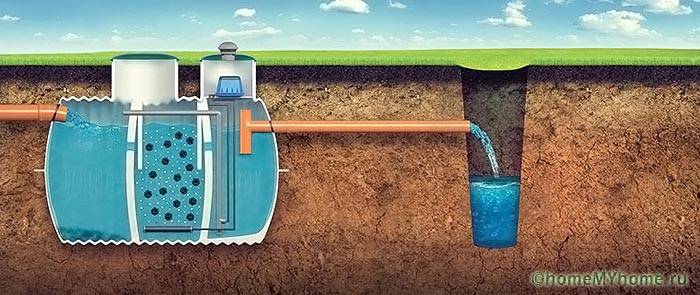
Anaerobic aeration tank
- combined systems - at the initial stage, anaerobic bacteria participate in the purification process, then the wastewater is purified by anaerobic microorganisms.
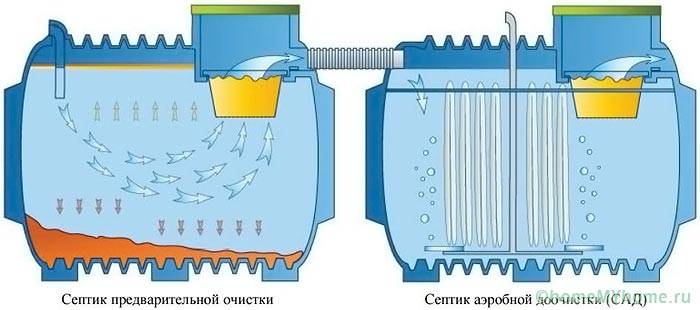
All autonomous sewage systems consist of individual elements:
- highway external sewerage– pipes through which wastewater flows by gravity (less often under pressure or vacuum) from the home into the chambers of the septic tank, aeration tank;
- treatment facility - metal, polymer, concrete tank, partitioned into several chambers, in septic tanks additional equipment absent, compressors are installed in aeration tanks;
- infiltration system - a well or filtration field in which treated wastewater is discharged into the soil through a natural filter (40 cm layer of crushed stone, shungite, sand) for natural post-treatment with soil.
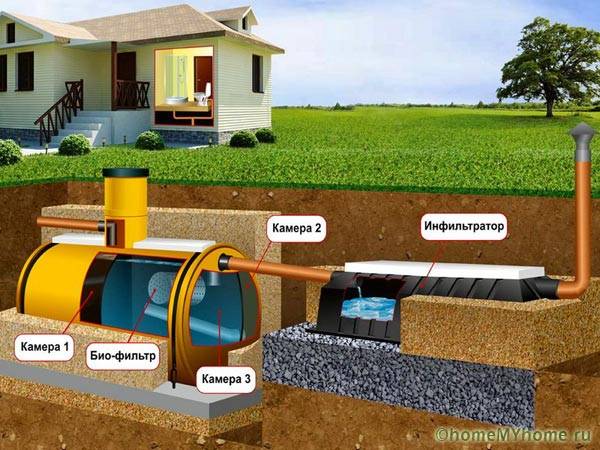
Filtration wells have a minimum construction budget, but are suitable exclusively for sandy soils and areas with a groundwater level lower by 1.5 - 5 m relative to the mouth. Filtration fields are buried below the fertile layer and can be used on clay soils. At high groundwater levels, the only option for an infiltration system is a ground filter. The effluent from the septic tank is pumped, collected in above-ground tanks, and usually reused.
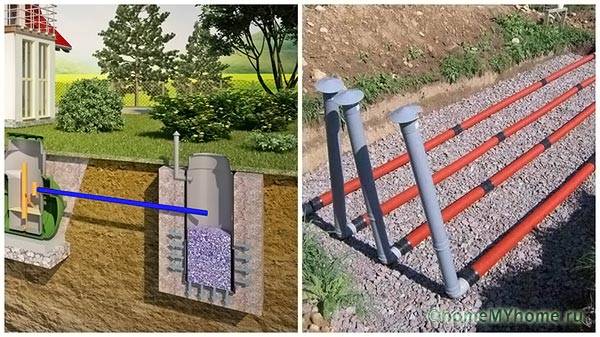
Wells do not require filtration ventilation system, for fields it is a prerequisite for safe operation. The filtration field consists of several contours or beams of corrugated pipes perforated with small holes. Unlike drainage systems, the liquid is not collected in them, but is discharged onto the underlying layer of crushed stone. After which, the wastewater seeps into the soil, is purified, and ends up in underground layers.
Autonomous sewer design
The industry produces underground tanks from different materials with different characteristics. Therefore, when purchasing an autonomous sewer system in a private house, how to choose the appropriate equipment and characteristics for a particular facility is the most pressing question for the developer. At the design stage of the drainage system, it is necessary to take into account the following nuances:
- anaerobic bacteria reproduce on their own, septic tanks can be used periodically;
- aerobic wastewater treatment systems are energy-dependent, microorganisms die during seasonal operation, long-term shutdowns necessary for the operation of compressors, activated sludge must be periodically renewed;
- in gravity pipelines from the building to the septic tank, a slope of 4 - 7 degrees is required, if you make the angle smaller, the wastewater will stop flowing into the tank, with large slopes the self-cleaning ability is reduced, blockages are possible due to the accumulation of large fractions;
- When backfilling plastic tanks, they must be partially filled with water so that the walls are not compressed by soil, which is important in areas without sources;
- in septic tanks manufactured industrially, the pipe entry points have high tightness, and it is much more difficult to insert lines into concrete rings;
- polymer septic tanks are not always loaded with wastewater; during winter heaving of the soil, these structures can be squeezed out to the surface, so a slab is laid or poured under them, to which the tank body is tied.
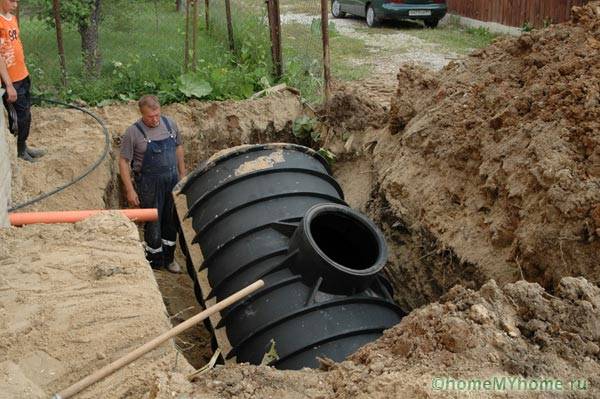
The size of the septic tank is chosen based on the volume of the first chamber; this figure should be 3 times the daily water requirement of the family. For the convenience of periodic pumping of sewage, underground tanks should be located closer to the roadway. Laying depth treatment plant always individual. In this case, it is necessary to take into account the length of the sewer line, the slope of 4 - 7 degrees, and the winter freezing mark in the region.
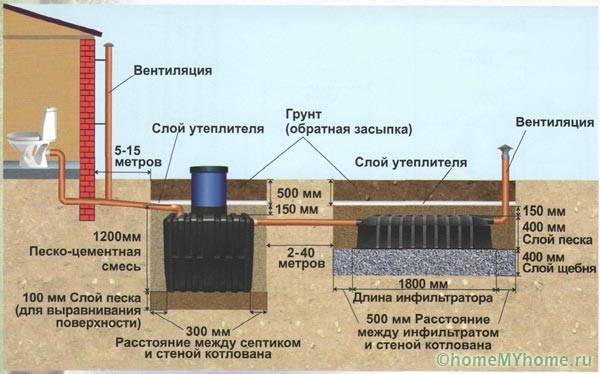
Making an autonomous sewer system with your own hands
In principle, to install a VOC or septic tank, it is enough to determine the location of the tank, dig a pit for it, and connect it with a direct trench to the outlet collector of the internal sewer riser of the home. Then install the tank, pipes, make an infiltration system, and backfill.
However, there are nuances at each stage. Therefore, you can accurately choose which autonomous sewage system will be used and how to select individual elements with a minimum budget by following the recommendations of SP 32.13330 for external engineering systems drainage.
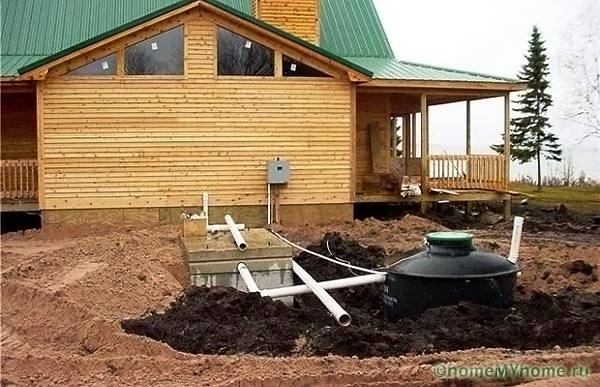
Related article:
In a separate publication you can read how to choose a sewage pump, its design and what parameters are used to select it.
Integration on site
When choosing a location for operating a water treatment system, you should take into account the requirements of regulatory documents:
- distances to objects considered significant - trees 3 m, water intake source 30 - 50 m, border neighboring plot 2 m, “red” line of the roadway of the street 5 m, driveways 3 m, foundation of the dwelling 4 m, natural reservoirs 10 m;
- infiltration systems - safe distances are similar to the previous case.
In addition, you should take into account the passage of paths around the site, recreation areas, and parking to ensure maximum living comfort.
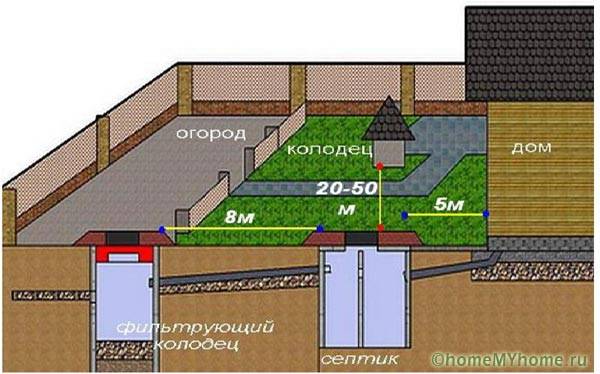
Attention! It is prohibited to divert drainage, storm drains, drain water from ponds and pools to avoid overflowing chambers and soil contamination.
Earthworks
Any underground structures are inevitably subject to the forces of frost heaving. They are eliminated by insulating the perimeter of the base of the structure, drainage, using non-metallic materials in the underlying layer, and backfilling the pit sinuses.
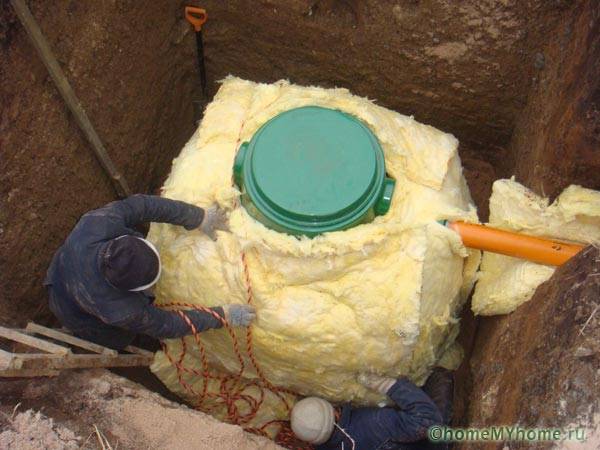
For septic tanks, the first two technologies are not used; the sinuses are filled with ASG or sand. Therefore, the dimensions of the pit should be larger size containers 40 cm around the perimeter. The laying depth is calculated as follows:
- underlying layer – 10 – 15 cm;
- concrete slab – 10 – 15 cm, only for plastic structures;
- level of freezing - due to the fact that the wastewater comes from the building, it always has a positive temperature, during decomposition by bacteria, organic matter is released thermal energy, a depth of 1.5 - 2 m is sufficient.
The trench from the tank to the cottage should have a slope of 4 - 7 degrees. For this, a height difference of 2–3 cm at a distance of one meter is sufficient.
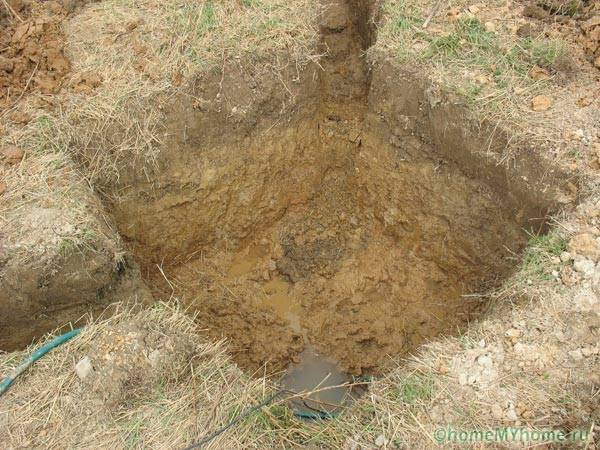
The underlying layer is made of sand on dry soils, crushed stone at high groundwater levels. Layer-by-layer laying of every 15 cm with compaction using a vibrating plate is required.
Tank installation
Polymer containers are usually installed manually, metal, concrete septic tanks placed with a crane. If necessary, for lightweight structures, a concrete slab without reinforcement is cast on top of the underlying layer. The tank should be positioned horizontally to make the most efficient use of the internal space of the working chambers.
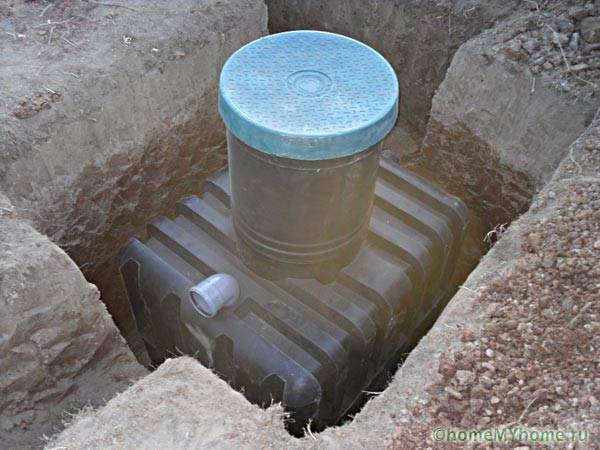
Laying external sewerage
The main is assembled from red sewer pipes with a diameter of 11 - 20 mm. Before installing the communication system, it is necessary to carry out the following work:
- laying a geotextile fabric on the bottom of the trench, the edges of the material are launched onto the sides;
- underlying layer of crushed stone or sand 10 - 15 cm;
- tamping of inert material with a vibrating plate;
- laying pipes with a gravity slope;
- backfilling with crushed stone or sand;
- covering with geotextiles.
This technology will eliminate soil subsidence and spontaneous detachment of bells. Geotextiles prevent mutual mixing of soil with non-metallic material.
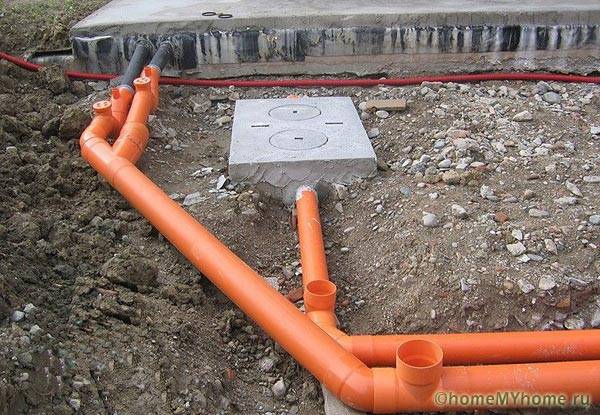
Video: how to properly lay sewer pipes
All input nodes are sealed with rubber and silicone cuffs to prevent leaks. If necessary, internal equipment and overflow pipes are installed. PVC pipes are most difficult to seal when passing through concrete rings. For this purpose, penetrating mixtures are used, added to the cement-sand mortar.
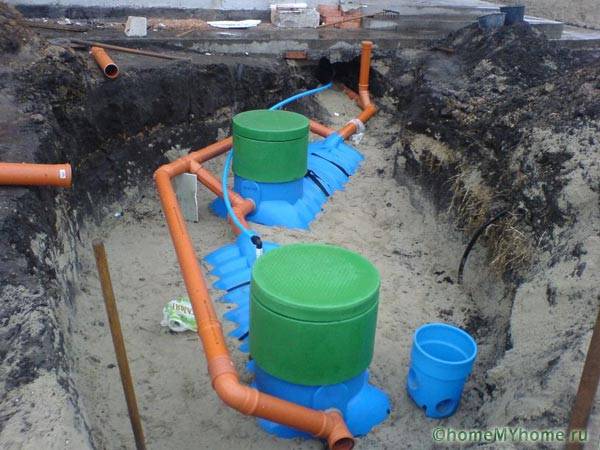
Infiltration systems
The infiltration well is made of concrete rings. The structure does not have a bottom; instead, a 40 cm layer of crushed stone, shungite, and gravel is filled in. Filtration fields are manufactured using the following technology:
- soil is removed in an area, the size of which depends on the filtering capacity of specific soils in the building area;
- the perimeter is covered with geotextiles, preventing siltation and mixing with a layer of material;
- a drainage layer is created from crushed stone, on which beams of corrugated pipes or contours are laid;
- the structure is filled with the same natural filter, then with soil.
Manufacturers of septic tanks produce special infiltration elements, the design of which is a hybrid of a field and a filtration well. They are mounted in a standard way.
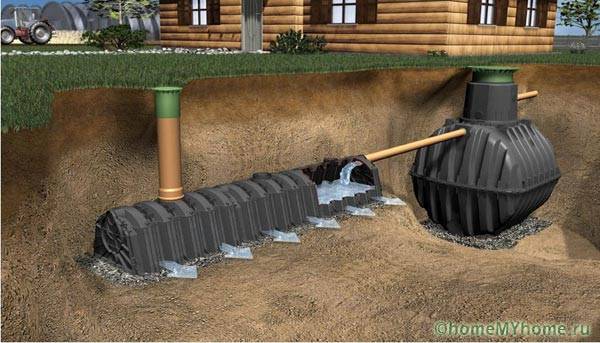
Backfill
When using non-metallic material in the sinuses of the pit, it is possible to completely eliminate the pull-out loads from freezing soils that act on underground tanks. To do this, a 40 cm layer on all sides of the septic tank is enough, but layers of 15–20 cm should be laid, each compacted with a vibrating plate or hand tools.
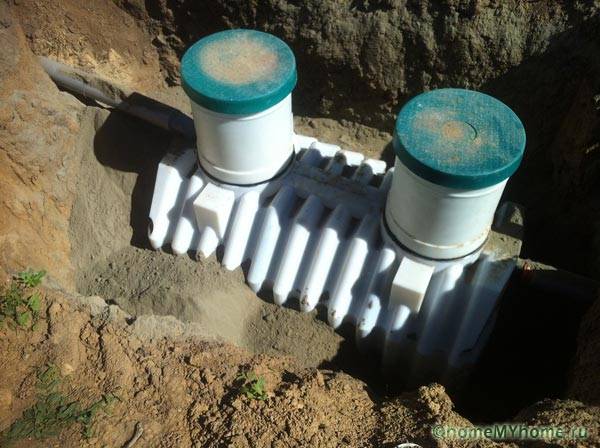
Decorating the hatch
To service septic tanks, openings with hatches extending to the surface are used. To maximize the integration of this communication element into the landscape of the site, decorative products produced by industry are used. Usually these are figures of animals, fairy-tale characters, mushrooms, stumps, and boulders made of polymer materials. They are easy to remove, weigh almost nothing, have a reliable fastening, and do not blow away in the wind.
Life in country house It has long ceased to resemble life in camp conditions. Today's country houses have full bathrooms, bathtubs, sinks, and some houses even have swimming pools, saunas and baths. However, these attributes require not only the supply of water, but also further drainage waste water. House sewerage is one of the most important systems that ensures comfortable living in the house. There are several main types of septic tanks or, as they say, autonomous sewers. In this article we will discuss what types of them exist and how to choose autonomous sewerage For country house.
2.
2.
To make an autonomous sewer system in a private house, you need not only to locate communications inside the building, but also to think about what to do next with the wastewater: just accumulate it in a container or will a deep cleaning station be needed. Take a look at the options available today.
Autonomous sewage system in a private house - selection rules
When choosing an autonomous sewer system, the first thing you need to do is think about where the wastewater will be discharged from the house. The choice of a septic tank largely depends on factors individual for each case. Factors influencing the choice:
- Bedding level groundwater. Is it possible for the site to be flooded during spring floods?
- Type and structure of soil on the site (chernozem, peat, clay, sand, etc.);
- Features of the climate in which the site is located and the depth of soil freezing;
- Number of people living in the house;
- The amount of water consumed daily by one person;
- Dimensions of the plot. What territory can be allocated for the installation of treatment facilities;
- Relief of the site. Is there a slope and, if so, in what direction?
There are several types of autonomous sewage systems for a country house. Each of the options considered is well used in one case or another.
Types of septic tanks
Sealed container for septic tank
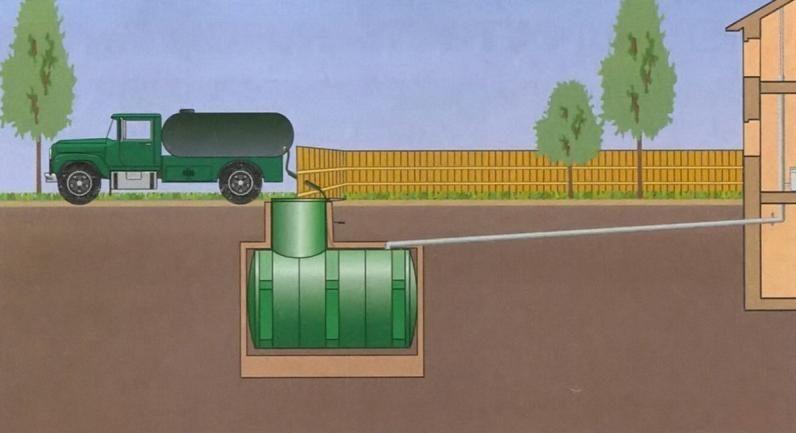
An airtight container for draining can be made of concrete, brick or some kind of plastic. The wastewater is drained and accumulated in this container. During the operation of the container and its filling, it is necessary to use a sewer truck to pump out the contents of the septic tank. In practice, it is noted that such a container is filled quite often. Therefore, the relatively small cost of constructing such a septic tank is compensated by constantly calling sewer trucks to pump it out. This option is suitable if 1-2 people permanently live in the house or residents appear from time to time, i.e. there are no permanent residents in the house. This option is also suitable for a house located on an area with a high groundwater level or that is subject to seasonal flooding.
Two-chamber septic tank or overflow wells
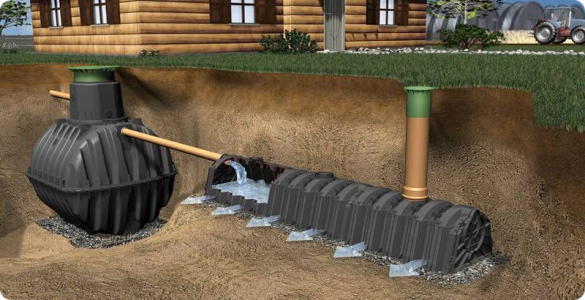
This type of autonomous sewage system can be purchased ready-made or built independently. In this type of septic tank, the first container has a sealed bottom and is used to allow the wastewater to settle: solid elements settle to the bottom, light particles float to the surface, and the water purified from these elements remains in the middle. It is this water that is poured into the second well through an overflow pipe, which no longer has a sealed bottom. In the second well, this water is purified by passing through layers of sand, crushed stone and soil. Over time, an excessive amount of sludge accumulates in the first well, which also needs to be pumped out using sewer trucks. The frequency of pumping is on average once every 4-6 months for a family of 4-5 people. This type of treatment facility is only possible in an area where the groundwater level will never reach higher than 1 meter from the bottom of the septic tank, and the ideal case would be sandy or sandy loam soil of the area.
Septic tank with filtration field
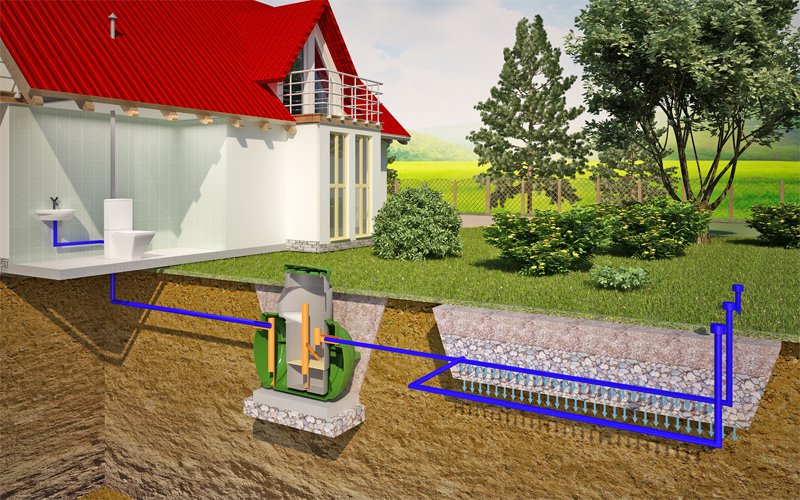
This type of treatment facility requires large number free space. It is a container that is divided into 2-3 sections. The first is necessary for settling water. The second is intended for processing by anaerobic bacteria. The third section is a distribution well, from which a pipe extends to the filtration field. The field itself should occupy about 30 m2 below the surface of the earth at a depth of at least 1 meter, which is covered with sand and crushed stone. The water passing through the filtration field is finally clarified and penetrates into the soil. This type of treatment plant should be chosen for large areas where there is a lot of free space and the groundwater level is not higher than 3 meters from the surface.
Biological treatment station
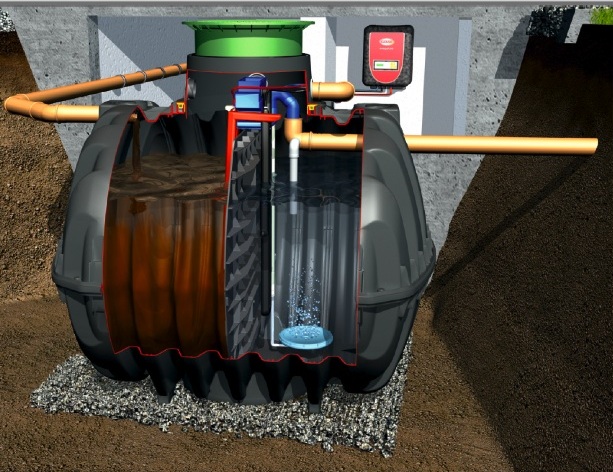
Such a septic tank is a container that is divided into 3-4 parts. In each section, a certain part of water purification occurs. Cleaning occurs with anaerobic and aerobic bacteria. After cleaning in such a septic tank, process water is obtained, which can be used for household needs. The drain is cleaned by 98-99%, which is undoubtedly a high figure. The bacteria used in the construction are added independently; you can, for example, pour them into the toilet. A huge advantage of such a structure is its autonomy and energy independence.
Artificial treatment station
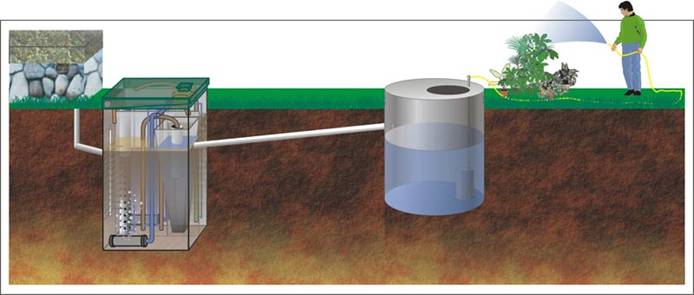
This type of septic tank differs from the previous septic tank in the type of bacteria used. The bacteria used in this facility require a constant supply of fresh air. Such a station requires a supply of electricity, from which the transfer and air pumps are powered. The cost of such a treatment plant is quite high, but its undoubted advantage is that it can process a larger amount of wastewater than a septic tank with a biofilter.
The last two autonomous sewage systems country houses suitable even for cases where the groundwater level is high, the area is flooded or there are many people living in the house. As you can see from the described types of septic tanks, there is plenty to choose from, but when choosing, you need to take into account the starting conditions and the available budget.
Video
Useful video about choosing autonomous systems sewerage for a country house.
The question of how to choose an autonomous sewer system for a private house is decided independently by each estate owner.
Today there is a lot of talk about the advantages of living in a private household.
And what is important to note is that a lot is being done. In particular, effective life support systems for private homes are being developed.
The owner of the estate has the opportunity to choose suitable system water supply and wastewater disposal. The offered systems are designed to suit any budget and customer qualifications.
When choosing a “tank” type septic tank, a significant amount of work can be done with your own hands. At those stages where there are not enough resources, it is necessary to invite specialists.
For a comfortable stay in a private country house, it is necessary to create appropriate conditions.
Complete water supply and electricity systems are created and installed in the shortest possible time. The situation is approximately the same with the arrangement of sewage systems and disposal of household waste.
Today the industry produces the following cleaning devices:
- septic tank based on a sealed container;
- septic tank based on overflow wells;
- station with a platform for filtering wastewater;
- biological treatment station;
- artificial wastewater treatment station.
Many owners of private houses speak positively about the “tank” cleaning system.
Before making your final choice, you need to know that the autonomous sewage system of a country house must meet certain sanitary standards.
The owner of a private plot needs to have a good knowledge of the geological features of the soil. And first of all, the depth of groundwater.
If fecal runoff contaminates aquifers, residents and neighbors will have to use additional filters at water intake devices.
This situation should not be allowed under any circumstances. We also have to take into account the climate. In particular, the depth of soil freezing.
This important parameter, which affects the operating costs of the drainage system.
To do right choice, it is necessary to take into account the quality of the soil. It’s one thing when there is black soil with sand on the site, and quite another if the soil is clay.
In this context, it should be noted that a “tank” type sewer is suitable for any soil.
The next parameter that influences the choice of sewer system is the number of people living in a private house.
If we evaluate the experience of other countries, then in China one person can use 100 liters of water. In the USA this norm is close to 300 liters.
In relation to a specific task, the sewer system must receive and process the entire volume of wastewater coming from a private home.
The operating principle of some treatment stations is based on the use of the filtering properties of soil.
In order for the cleaning system to function properly in all seasons, a certain place must be allocated for it. According to average data, an area of up to thirty square meters is required.
If private plot has a small area, it will not be easy to find space for such equipment.
The most suitable option today is considered to be an autonomous sewage system based on “tank” products.
If necessary, you can install it yourself and do not involve third-party specialists. The photo shows circuit diagram this device.
The principle of operation of the sewerage “tank”
An autonomous sewer system for a private home should serve reliably, regardless of the time of year. In winter, the contents in the tanks should not freeze.
In the summer, when it is hot, odors from sewer storage facilities should not bother people living in a private house and guests too.
The mechanism of operation of an autonomous sewage system “tank” is not complicated. The main tank is divided into several communicating sections. Fecal water from the house enters the first section through a pipe.
Here, the entire incoming mass is divided into liquid and solid components. Solid fragments sink to the bottom.
Fatty and oily fragments collect on the surface. Water accumulates in the middle.
Water flows through specially installed overflow pipes into the second section. Chemical water purification is carried out here. It is affected by special reagents.
Specially developed chemicals bind salts dissolved in water and settle at the bottom in solid form. The next stage of wastewater treatment is biological treatment.
This happens in the third section. Special types of bacteria are used here. If they consume oxygen, they are called aerobic. If they do without oxygen, then they are anaerobic.
As a result of biological treatment, sludge is formed, which is used as fertilizer.
At the exit from the third section, the water has good quality and she is sent to the infiltrator. This is a special absorbent area. The final purification of wastewater takes place there.
This is how the cleaning system works in a private area. The operating principle of an autonomous sewage system allows the owner not to interfere with the cleaning process.
With your own hands, you will only need to call a sewage disposal truck once every three to four years to pump out wastewater from the first section of the “tank” system.
It is this property that makes autonomous sewerage attractive for use in individual housing construction.
Features of the autonomous sewage system “tank”
Typical private house designs include an effective energy saving system. Construction is carried out in such a way that in winter the house is warm with minimal fuel consumption.
And in the summer it was not hot on the hottest days. A large list of construction work is supposed to be done with your own hands.
From this brief explanation it follows that, as a rule, no resources are provided for special heating of autonomous sewage systems.
It is not provided because effective systems for treating household wastewater have been developed based on a non-volatile mechanism. The “tank” sewage system belongs to this type.
Advantages of autonomous sewerage
The first thing to note is that the autonomous “tank” sewage system does not require heating. Second most important quality– tank strength.
The photo shows a polypropylene tank with a ribbed surface. This constructive solution gives the container strength comparable to that of brick.
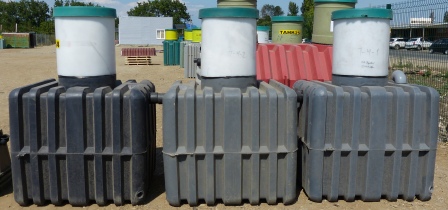
The next argument that all developers take into account is ease of installation. The installation of the tank can be done with your own hands in two to three hours.
The estimated service life of such a sewer system is 50 years. Thanks to the technology used, wastewater treatment meets all sanitary and environmental standards.
Disadvantages of autonomous sewerage
In front of everyone positive qualities autonomous sewage system “tank”, it has some features that must be taken into account.
If there is shallow groundwater in the area, then when installing the tank it is necessary to pour a concrete base.
Or lay a finished reinforced concrete slab.
Despite all the positive characteristics of the system, you still have to use the services of a sewer truck.
In hot summer weather, an unpleasant odor may appear.
Installation of autonomous sewerage
When developing a project for a private house on a country estate, the autonomous sewage system is considered as an integral and integral part of the entire complex.
This means that all construction and installation work are carried out taking into account the requirements for sewerage.
Often, when performing ground work, at the same time as digging a trench for the foundation, a pit for a sewer tank is also being dug. The photo shows the layout of the septic tank on the site.
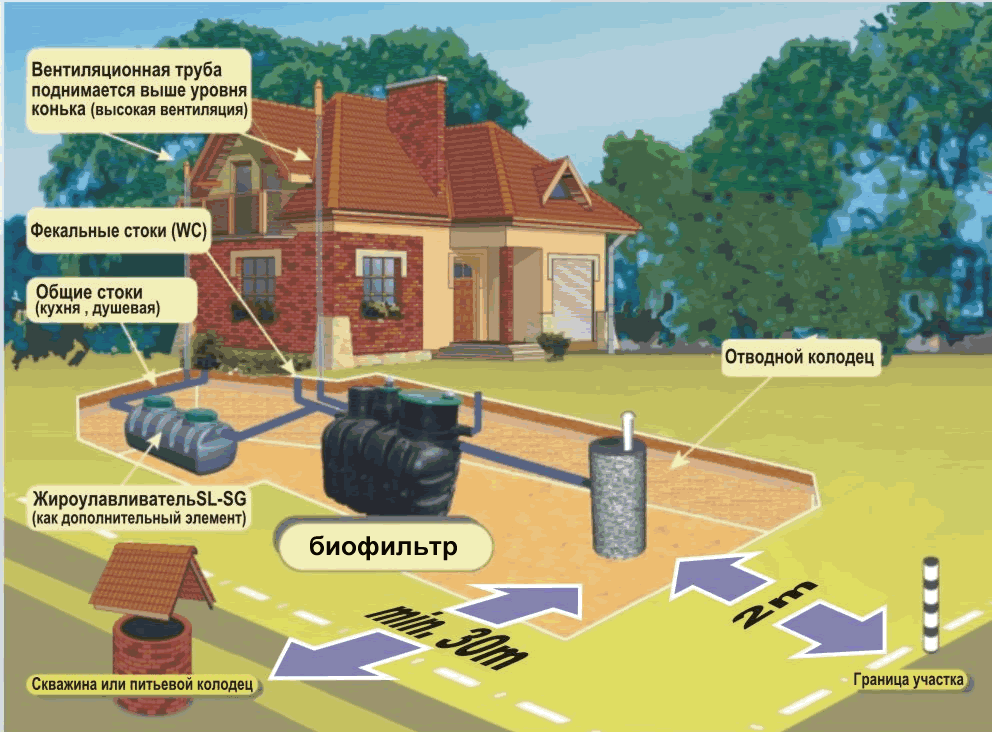
The installation of the tank begins after the house is completely erected. Internal sewerage has been installed. And after that, you can begin installing an external autonomous sewage system.
The pit for installing a sewer tank should be no closer than five meters from the house and no further than 15 meters. The photo shows the installation dimensions of the tank in the pit.
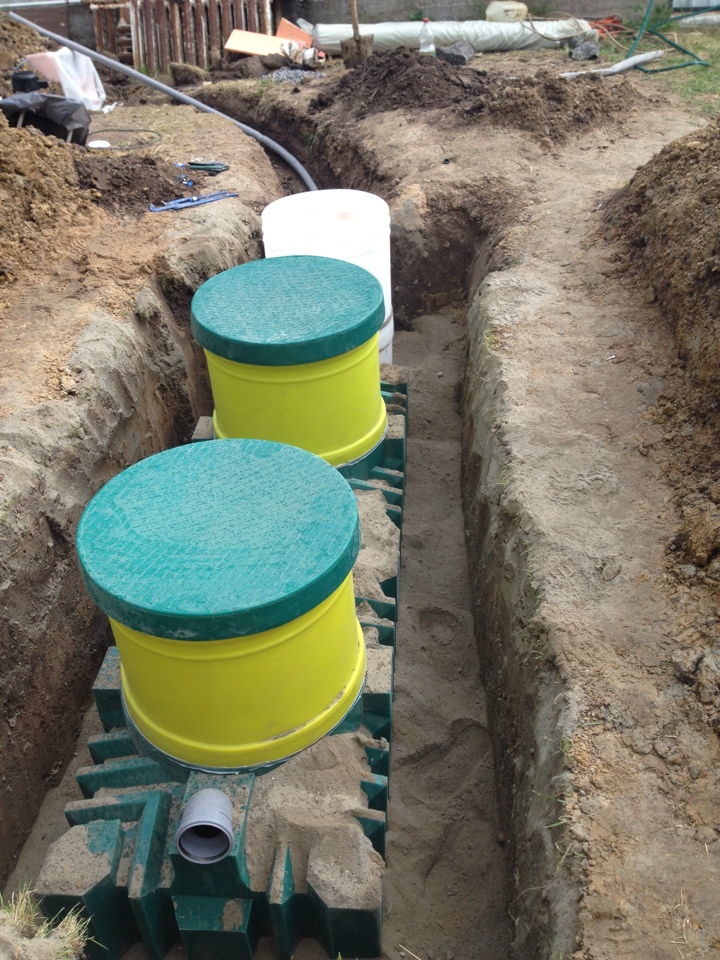
The first thing to do is level the bottom of the pit and fill it with sand. The layer of sand should reach 30 cm. Before installing the septic tank in the pit with your own hands, you need to carefully inspect it.
The main reservoir and infiltrator are installed in a pre-prepared pit. The distance from the septic tank to the walls of the pit must be at least 25 cm.
Before filling, the tank must be gradually filled with water. This is done to increase the strength of the septic tank.
In the pit intended for the infiltrator, the bottom is covered with geotextiles. This must be done. Geotextile is a fabric made of synthetic fibers.
Its main property is that water flows freely through the fabric, and particulate matter are delayed. The operating principle of any filter is based on this property.
The material is spread so that its edges protrude beyond the edges of the pit. A layer of fine crushed stone up to 20 cm thick is poured onto the geotextile.
To do this, it is advisable to choose a smaller fraction. An infiltrator is installed on this layer of crushed stone. And the top is covered with a geofabric sheet.
A ventilation pipe must be installed at the outlet of the infiltrator. A layer of insulation must be placed on top of the infiltrator. And after this, the device is backfilled with soil.
The main tank is filled with a sand-cement mixture in a ratio of 5:1. You can fill it with sand. During the work, the sand needs to be compacted.
All pipes that are laid in the ground must have a slope of at least two centimeters per meter of length. In regions with harsh climates, pipes need to be additionally insulated with your own hands.
Some nuances
If three people permanently live in the house, then you need to choose tank “tank” No. 1.
Septic tank No. 3 is designed for 6 people.
The labeling principle is formed incrementally.
The higher the number, the larger the tank volume.
It must be remembered that saving when choosing a septic tank is unacceptable.
It is preferable to have a small reserve of septic tank capacity.
To ensure that life in a private house does not resemble camping conditions, it is necessary not only to supply water, but also to ensure the removal of wastewater. There are several types of sewer systems, which allows you to choose for a particular area the option that is most suitable in terms of cost, method of operation, and capabilities. In this article we will talk about autonomous sewerage and its types.
The simplest type country sewer. To make cesspools:
- You don't need to spend a lot of money.
- It won't take much time.
- You can use any available material for construction.
This is where all the advantages end. But there are a number of disadvantages, and quite significant ones:
- The presence of an unpleasant odor.
- There is a possibility that not only soil but also water may be contaminated.
- It is necessary to frequently call a sanitation specialist to clean the system, which is associated with high costs.
- In winter, the pit can freeze very deeply, which prevents the treatment of wastewater, and therefore the ability to use it.
Many owners of private plots, in order to facilitate the maintenance of the cesspool, make it without installing a special bottom that filters the drains. Unfortunately, such tricks are punishable, since a number of laws prohibit the use of cesspools without a bottom.
Moreover, the use of cesspools is unacceptable if their volume is filled by 1 cubic meter or more.
If you still decide to choose the construction of a cesspool, you need to make a pillow at the bottom:
- The first layer is coarse sand.
- The second layer is crushed stone.
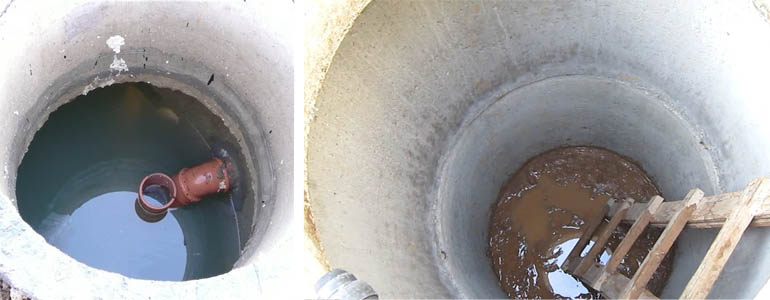 A cesspool using concrete rings provides increased strength and tightness of the structure.
A cesspool using concrete rings provides increased strength and tightness of the structure. Dry toilet
This is the name given to the design with a plastic container. Consists of a cabin and two tanks. At the top there is a container with clean water for flushing the toilet, and at the bottom under the booth there is a container for waste. There they are cleansed.
Dry toilets can be purchased as portable or stationary, which allows you to choose the system that is most suitable.
In this video, Elena Malysheva advises how to choose a dry toilet:
In a stationary dry closet, sewage is cleaned with organic or chemicals. The system can be installed both inside the house and outside. Both options have their drawbacks: a structure located in the house will very soon make itself felt with unpleasant odors, and one installed outside can collapse in the winter, since it is not designed to withstand the weight of snow or ice.
Advantages of dry toilets:
- Compactness.
- Mobility.
- Easy to care for.
- Low cost.
- Long working time.
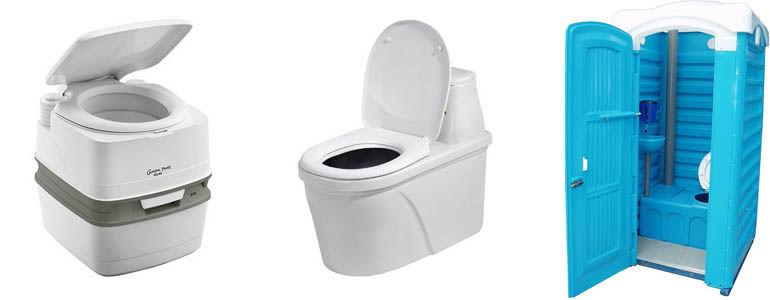
This type of system is one of the most reliable, efficient and affordable. Thanks to their use, you can clean drains and eliminate any unpleasant odors.
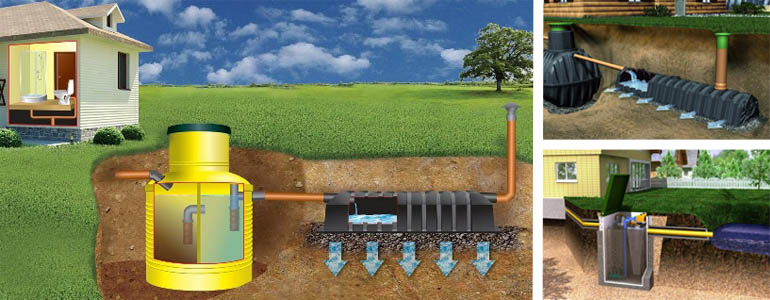
Advantages of autonomous sewerage:
- Compact dimensions.
- Safety.
- High tightness.
- Possibility to install on a site with any type of soil.
- Duration of operation - sewerage can operate effectively for over 20 years.
But the most important thing: the presence of an autonomous sewer system allows you to install a shower and everything that is necessary for a comfortable life in a private house. We are talking about dishwasher and washing machine, toilets, bidets and other achievements of civilization.
If you plan to install an autonomous sewer system, you must remember that you will need to lay a large number of communications. If work is carried out in a new house during its construction, the work will not be so difficult. If the sewerage system is installed in a habitable private house, you will need to drill the walls and remove the floors in the required areas. Therefore, if possible, it is best (and cheaper) to make a sewer network during the construction of the building itself.
In this video watch about various types autonomous sewerage devices:
Types of systems
Waste recycling can be carried out
- Soil filtration.
- Deep biological treatment.
Soil filtration
If soil filtration is expected, multi-chamber septic tanks are used. Moving through the chambers, the wastewater is cleared of solid waste, which decomposes almost completely, for which anaerobic bacteria are used. The purified water then enters a filtration well or field where underground filtration takes place.
Advantages:
- Low cost.
- Minimum maintenance costs.
- Durability.
Flaw: Untreated wastewater may end up in groundwater.
Biological treatment
A monoblock and other equipment are used for biological treatment. This is a control unit, pump, compressor. In order for anaerobic bacteria to process wastewater faster, the compressor supplies air masses. The treated waste and sludge are pumped over.
Advantages of the method:
- Compactness.
- No need for a vacuum cleaner.
- Excellent wastewater treatment.
Flaws:
- Electricity consumption.
- Maintenance required.
- To maintain the station, you will need to spend money.
- It is necessary to ensure that no aggressive chemicals enter the system, which can kill bacteria.
Operating principle
An autonomous station, designed for a private home, combines a cleaning process in which naturally occurring air and microorganisms act on the wastewater. Under this influence, wastewater components are oxidized. Or rather, the microorganism destroys organic substances. The remaining wastewater can no longer rot; over time, it is cleaned and becomes transparent.
After aeration cleaning, the output can be water intended for technical purposes. The best organic fertilizer there will be the resulting sludge.
Sewage device
Since the manufacture of an autonomous network is a complex technical task, preliminary calculations must be made taking into account the following indicators:
- Soil structures.
- The relief of the site and its size.
- Number of permanent residents.
- The depth to which groundwater lies.
- Soil freezing depth.
When calculating, it is necessary to include a reserve of sewerage productivity. The perspective can be from 10 to 15-20% of the total system volume.
Options for autonomous sewage systems for a home with a large amount of wastewater:
- Biopurification system.
- Storage tank with filtration field.
- Storage tank with filtration well.
- Storage plastic or metal container.
The choice of option is influenced by the geological structure of the soil. It also matters how large the volume of household waste is. For example, if there are artesian wells nearby, it is impossible to build a system with filtration wells or a field in accordance with the relevant Law of the Russian Federation.
Selecting a waste container
Containers where wastewater will be collected can be built from existing available materials (for example, stone, brick) or purchased ready-made. Among all the materials that can be used by manufacturers to make containers, plastic products are considered the most popular and most suitable. This became possible thanks to the many advantages that plastic has:
- Durability.
- Strength.
- Ease.
- Resistant to rot and rust.
- Possibility of installation without the use of expensive special vehicles.
- There is no need to install waterproofing.
- Availability of tanks of different volumes and shapes - round, oval, square, rectangular. Since it is easiest to make a hole for a container in a round shape, round containers are purchased most often.
There are also disadvantages. These include:
- High price. But this indicator cannot be considered a disadvantage, since during operation the money spent will be fully recouped.
- To prevent sewage from overflowing, it is necessary to equip the container with a filling sensor.
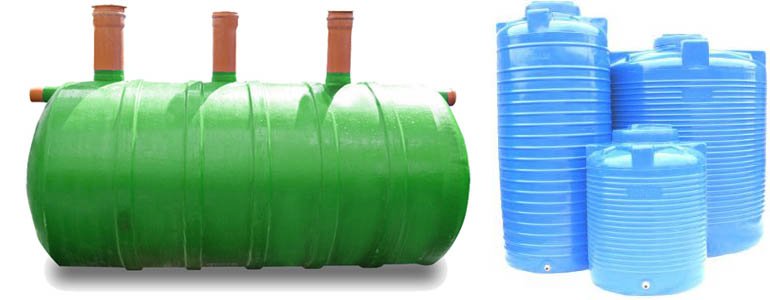
Features of manufacturing systems
Internal sewerage
Sewage pipes located inside the house have horizontal and vertical sections. In order for the sewage system to work smoothly and to avoid blockages, it is necessary to purchase pipes for risers with a minimum diameter of 10 cm. All horizontal sections must be located at a slope of 3 cm at every meter.
The best material for making a pipeline is plastic. It is least likely to cause blockages. In addition, this material is durable, lightweight, durable and inexpensive.
External networks
For the construction of private external networks, you can choose any material, so you can use pipes from:
- Polyethylene.
- Polypropylene.
- Polyvinyl chloride.
- Cast iron.
- Steel.
- Asbestos cement.
Since pipes are laid to storage areas, they also need to be laid at a slope. The level of laying external pipes should be located below the level to which the soil freezes. If this is not possible, then the pipeline must be insulated from foam freezing